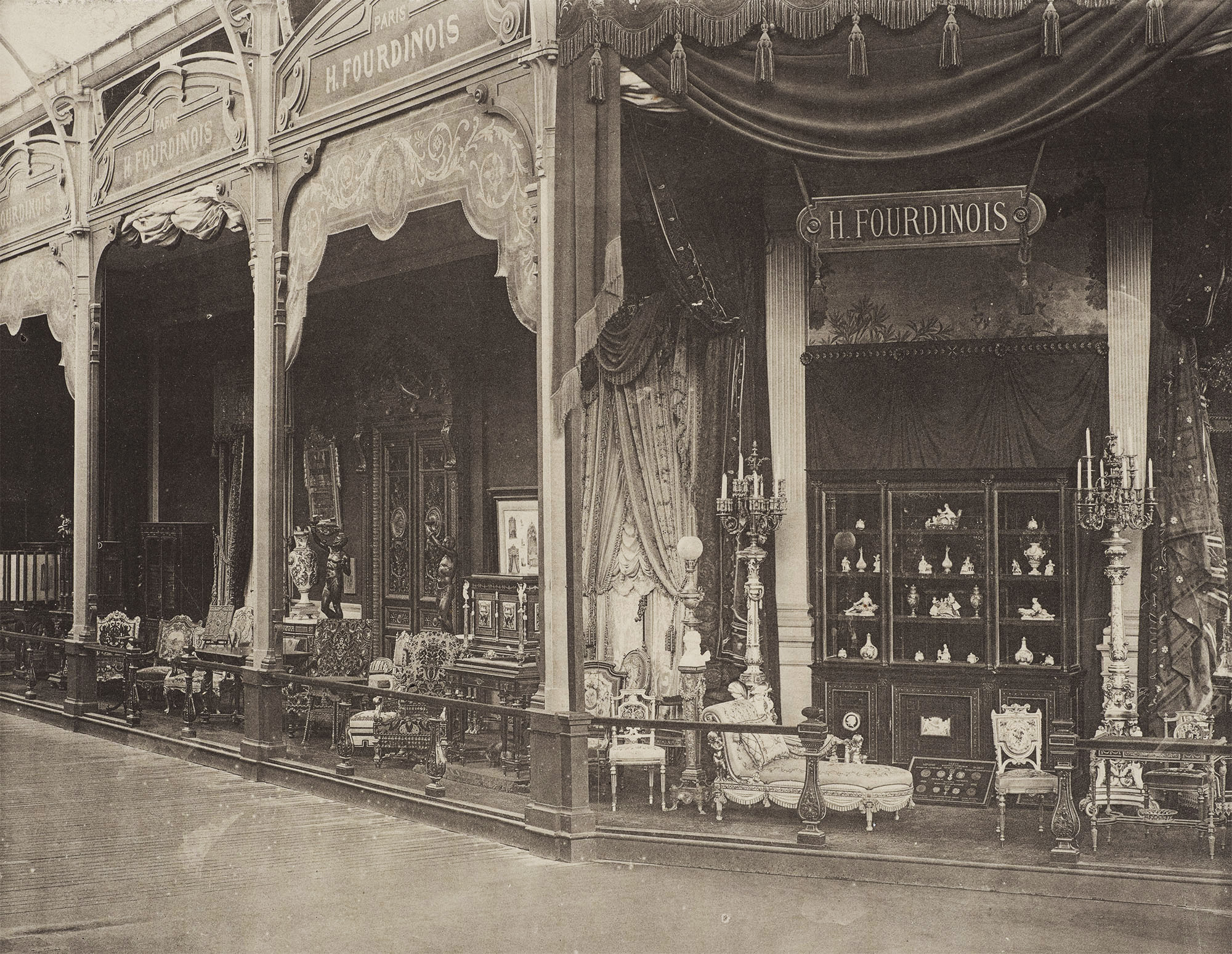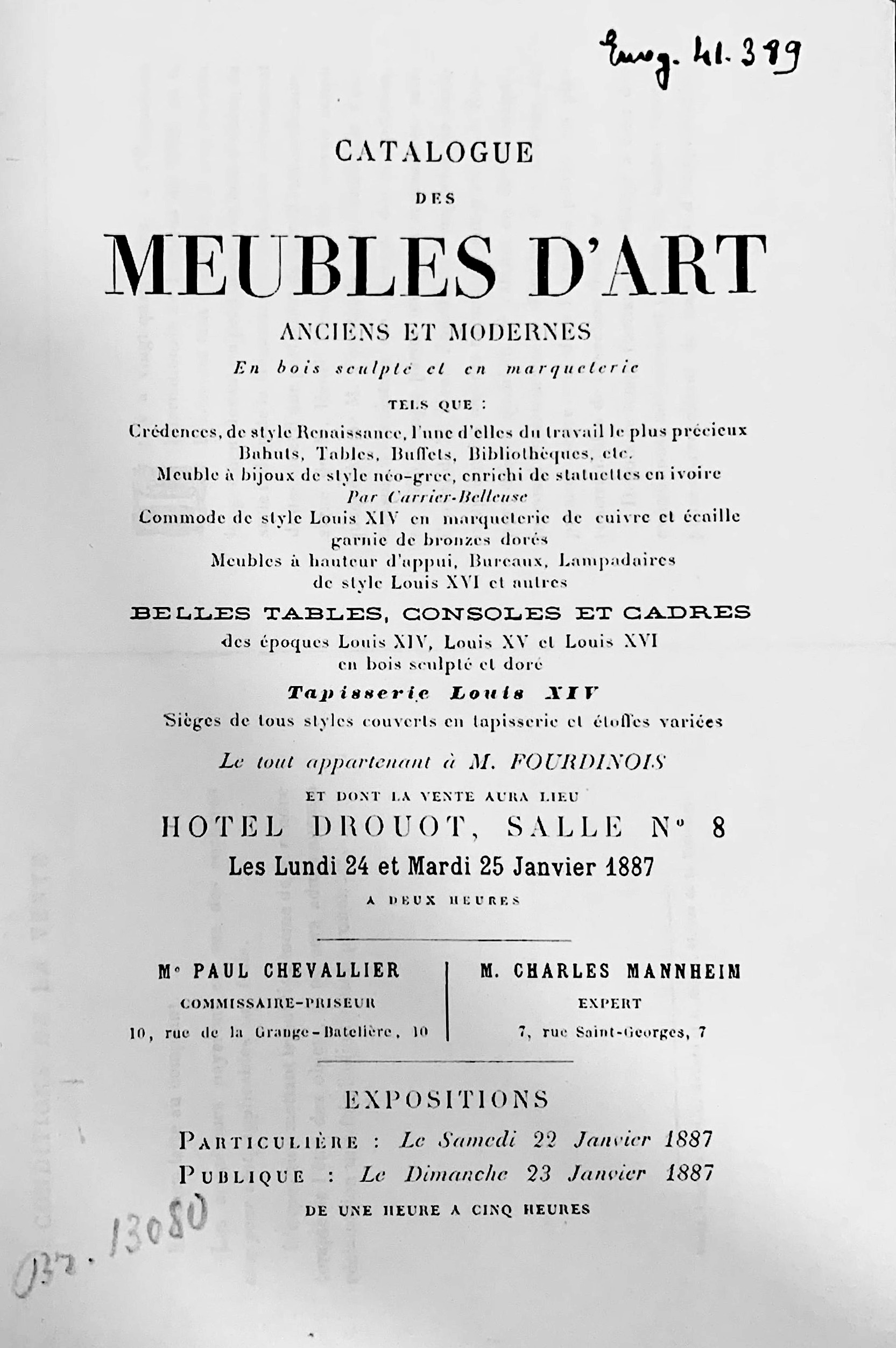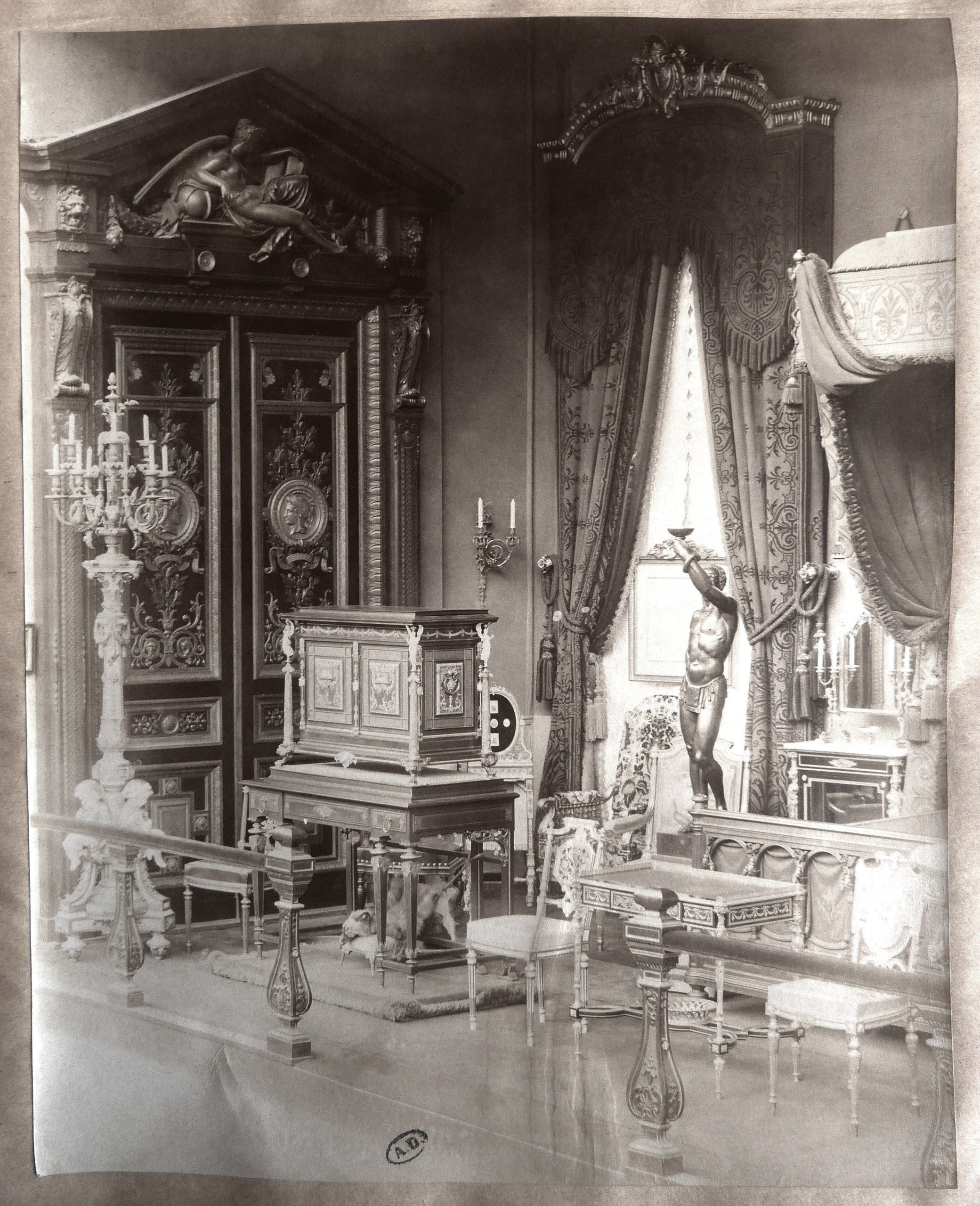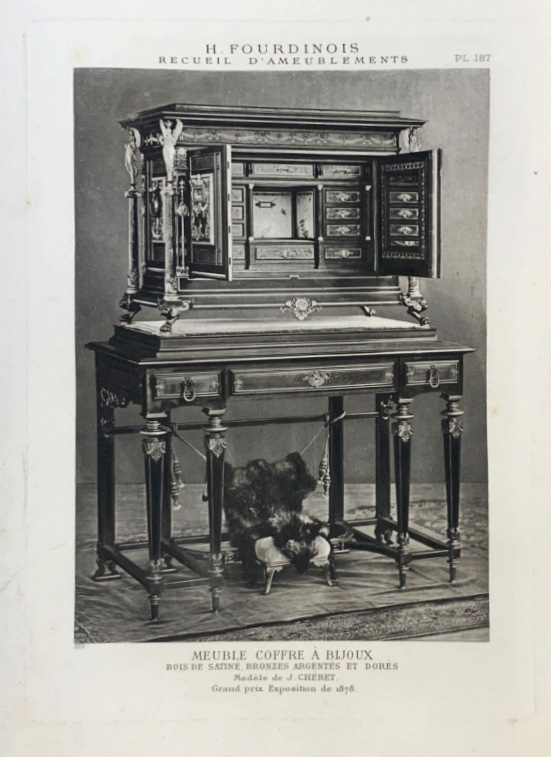Style Napoleon III / Ref.13100
Henri-Auguste Fourdinois, Exceptional jewelry cabinet - Gold medal in the 1878 International Exhibition
Dimensions
Width 50'' 127cm
Height 65'' 165cm
Depth: 24'' ⅜ 62cm
Status:
Good condition
Masterpiece of the International Exhibition of 1878, the jewelry cabinet showed by the Fourdinois house is a collaborative and successful effort between the Second Empire furniture genius, Henri-Auguste Fourdinois, and the designer and sculptor Joseph Chéret (1838-1894), the sculptor, Alfred-Ernest Carrier-Belleuse (1824-1887), and the enameler, Alfred Thompson Gobert (1822-1894). Already applauded in 1878, and rewarded with the Grand Prix of the exhibition, the jewelry cabinet is exhibited again in 1882 during the Exposition de l’Union Centrale des Arts Décoratifs, and in 1883 during the Amsterdam Exhibition to represent the national arts and industries on the French Pavilion.

Like the most furniture produced by the company, the jewelry cabinet is a perfect balance between very precious materials – for instance silver, ivory, or lapis – with a breathtaking know-how in the field of furniture, tapestry and bronze. “Nice jewelry furniture put on a satin wood table, decoration in silver, bronze, ivory, Neo-Greek style. The lower part shaped as a table with three drawers in the belt: the middle one with storefront knocking down to create a desk; in the inside a series of small drawers. It is supported by eight feet linked by crossties; the four feet in front are adorned, on the top and bottom, with finely chiseled bronzes; on the sides, a pierced and chiseled corner decoration. On the stride, a feet stool covered with blue velvet. The chest is adorned with silvered and gilt bronzes. The frieze, pilasters and panels decorations are in massive silver chiseled and inlaid following the Fourdinois proceed. The four corners are provided with lapis and bronze columns surmounted by small winged statues in ivory, composed by Carrier-Belleuse. On the doors, enamels by Gobert surrounded by decoration and fruit garlands in chiseled and inlaid silver. The middle part is furnished with satin. It is supported by four claw feet and leans on an embroidered blue velvet carpet.”


The use of decorative old styles, the richness of the materials, the research for excellence in all the creation fields make Alexandre-Georges and Henri-Auguste geniuses of their time for the deep understanding of the aesthetic, moral and economic aspiration of their society. Thanks to his apprenticeship with the furniture maker Georges Jacob-Desmalter Alexandre-Georges Fourdinois (1799-1871) created his company in 1828, and took as partner in 1835 another import artist, Jules Fossey. The first participation of the Fourdinois-Fossey association to an important event took place in the Exposition des produits de l’industrie in 1844, where their Neo-Renaissance dresser won a silver medal. Following this success, important buyers ask them for furniture, especially Louis-Philippe who orders Louis XIII furniture, or even the Dukes and Duchess of Nemours for their apartment in the Palais des Tuileries. Nevertheless, this profitable collaboration between Fossey and Fourdinois ended in 1848. In parallel, Alexandre-Georges prepares the artistic education of his son Henri-Auguste (1830-1907) : at the age of 16 he starts in the workshop of Félix Duban (1797-1870), attached then to the restoration of the Blois castle. His apprenticeship continued in England, forcing as many artists after the 1848 revolution to exile. He joins there, the silversmith Morel, and contributes to his new company standing Morel & Co during the International Exhibition of 1851. When he gets back to Paris, it’s with the bronze maker, Victor Paillard, that the young Fourdinois starts working, before finishing his formation by entering as a designer in one of the first tapestry houses. It’s around the year 1860 that Henri-Auguste starts to take importance in the Fourdinois company, even though there is a lack of information to prove it, and it’s only in 1867 that Fourdinois father definitively retires himself from the direction of the company. This same year is the one of recognition for Henri-Auguste, who shows in the International Exhibition a cabinet that goes directly on the collection of the South Kensington Museum in London, first and main decorative arts museum in this period of time. The Fourdinois booth, highly noticed, is also honored by the King of Spain, who buys the exhibited bed. The following years, the Fourdinois company continues to distinguish itself during the numerous International Exhibitions, like the one in Vienna in 1873, or in Paris in 1878. Henri-Auguste would have received all the honors that a furniture maker could have hoped for: in addition to the gold medal, the Grand Prix, the honor Diploma, he received the knight cross of the Legion of Honor in 1870. If its company, risking the bankruptcy, had to close its doors in 1887, it stays a symbol in its production of a taste and a way of life during the Second Empire whose splendor and luxury continue to amaze.

Albert-Ernest CARRIER-BELLEUSE (1824-1887) important sculptor of the second half of the 19th century, is mainly known for being Auguste Rodin’s master and for his marble busts. He achieved recognition in 1863, when Napoleon III bought him his Bacchante, today kept in the Orsay Museum. The Emperor will also give him his support during his whole reign. His work was highly influenced by the Italian Renaissance and the 18th century styles, which he contributes to bring up to date. He’s also, near the end of his life, Director of the works of art in the Sèvres Manufactory where his passing was marked by the renewal of the collection and the modernization of the style.Gustave-Joseph CHERET (1838-1894) was trained by designers before becoming, near 1864, one of the main assistants of the sculptor Albert-Ernest Carrier-Belleuse. He integrates his master style while building a reputation of his own with works he sends in the Salon des Artistes Français from 1863, and collaborates with houses like Christofle or Fourdinois. When Carrier-Belleuse died in 1887, he shortly took on the task of the works of art Director left unoccupied in the Sèvres Manufactory. He’s the author of many small sculptures, groups and statuettes but also vases, planters adorned with characters, scenes and diverse motifs. His Neo-baroque work announces in many ways the Art Nouveau. We owe him some decorations, fountains, and monumental fireplaces made for private mansion. During the Exhibition of 1878, Henri-Auguste Fourdinois shows the variety of his creations and his workshops’ capacity by presenting two monumental doors made in collaboration with many other artists and especially Joseph Chéret. These two doors are bought by the State in 1885 and are now part of the Orsay Museum’s collection in Paris.Alfred-Thompson GOBERT (1822-1894) trained as a painter in the Paul Delaroche’s workshop, he decided to dedicate himself exclusively to the enamel art to which he contributed to the outstanding renaissance. He made decorations for the Sèvres Manufactory and became director of the works of art between 1887 and 1891. Very talented, we unfortunately don’t know much of his work, most of it has been scattered, given as a gift by the Emperor Napoleon III. Nevertheless, some of them are still conserved in the Orsay Museum or in the Ceramic Museum in Sèvres.
Recommended for you :
Dimensions:
Width: 141
Height: 73
Depth: 70
Dimensions:
Width: 120
Height: 197
Depth: 45
Dimensions:
Width: 281
Height: 82
Depth: 156
Dimensions:
Width: 71
Height: 159
Depth: 47
Dimensions:
Width: 152
Height: 129
Depth: 61
Dimensions:
Width: 84
Height: 186
Depth: 49
Dimensions:
Width: 106
Height: 222
Depth: 45
Dimensions:
Width: 85
Height: 132
Depth: 54
Dimensions:
Width: 32
Height: 59
Depth: 22
Dimensions:
Width: 128
Height: 218
Depth: 44
Dimensions:
Width: 151
Height: 110
Depth: 85
Dimensions:
Width: 67
Height: 203
Depth: 32















